Search
Recent comments
- waste of cash....
6 min 3 sec ago - marles' bluster....
27 min 30 sec ago - fascism français....
31 min 35 sec ago - russian subs in swedish waters....
1 hour 10 min ago - more polling....
39 min 4 sec ago - they know....
5 hours 27 min ago - past readings....
6 hours 26 min ago - jihadist bob.....
6 hours 32 min ago - macronicon.....
8 hours 27 min ago - fascist liberals....
8 hours 28 min ago
Democracy Links
Member's Off-site Blogs
the jesuits' world at war… hitler and pigs...
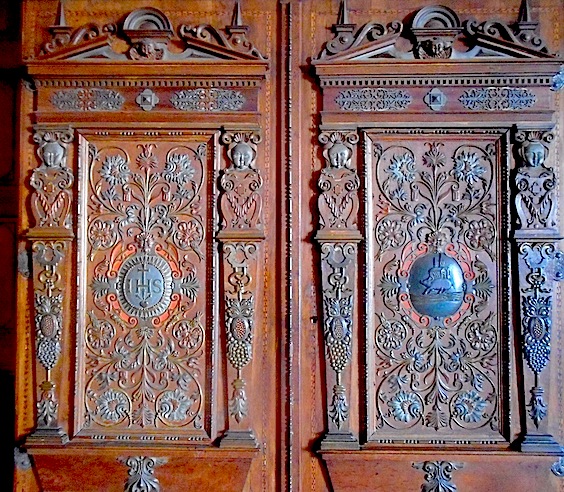
Jesuit doors in Germany... These doors are highly significant. On the left panel one can see the Jesuit symbol. On the right there is a pig. This is highly significant as well.
Here we must study this particular explanation:
Throughout history, the pig has been an animal with a deeply fraught significance for Christians and Jews as well as Muslims. Why, for example, are Jews forbidden to eat pig meat at the same time Christians happily serve up ham for Easter?
The answer may involve more than simply the biblical prohibition against Jews eating pork. If you understand the pig’s symbolism, you can understand the complex and often tortured relationship between Jews and Christians, says French cultural anthropologist Claudine Fabre-Vassas.
In her book “The Singular Beast: Jews, Christians and the Pig” (Columbia University Press, 1997), Fabre-Vassas depicts the pig not only as a beloved figure in medieval and modern Christian households, prized as both a pet in peasant cultures and a source of delicious food, but also as a symbol of a hated figure, the Jew, of the very group that scorns it as unclean. Fabre-Vassas argues that the cultural tension between those who did and those who did not eat pork helps set the stage for a murderous anti-Semitism.
The Jewish interdiction against the pig is first mentioned in the Old Testament. In Leviticus 11:27, God forbids Moses and his followers to eat swine “because it parts the hoof but does not chew the cud.” Furthermore, the prohibition goes, “Of their flesh you shall not eat, and their carcasses you shall not touch; they are unclean to you.” That message is later reinforced in Deuteronomy. Muslims, who follow Mosaic law, inherited the prohibition.
Over the years, various explanations have been offered for the Old Testament commandment. The 12th-century rabbi, Moses Maimonides, court physician to the Muslim sultan and warrior Saladin, said the prohibition against eating pig meat was for health reasons as it had a “bad and damaging effect” upon the body.
Beginning in the 19th century, scholars offered a different explanation. In “The Golden Bough,” Sir James Frazer wrote that pig meat was forbidden because it had originally been an animal used for sacrifice. “All so-called unclean animals were originally sacred,” Sir James wrote. “The reason for not eating them is that many were originally divine.”
Read more:
http://www.spokesman.com/stories/1998/mar/28/pig-as-symbol-barnyard-animal-holds-significant/
This is relevant to the way that Rhodes and his conspirators started WW1. See:
https://off-guardian.org/2018/11/13/watch-the-ww1-conspiracy/
Picture at top by Gus Leonisky. What follows below HAS NOT BEEN DOUBLE CHECKED BY GUS. But this makes interesting reading in regard to the history behind the History... It could be totally bogus, especially in its claims about Hitler. See also:
http://www.yourdemocracy.net.au/drupal/node/34711
The Jesuits in Germany
Germany is the home of the blessed Reformation so we should expect that the wrath of the Jesuits should be especially directed against that country.
Because of the great apostasy or falling away from the Apostolic Faith at the time of Emperor Constantine, a Reformation was absolutely necessary to return the world to Apostolic Christianity.
The trend of human nature is always to become more corrupt unless Reformers stem the tide of evil.... Many tried to reform Christianity before Luther, but their attempts were drowned in blood. By the 6th century, Hibernian missionaries found Christianity in Europe to have totally departed from the Apostolic Faith.
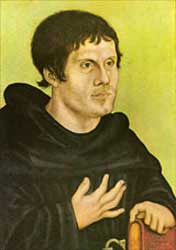
Saint Martin Luther (Nov. 10, 1483- Feb. 18, 1546).
Saint Martin was only 34 years old when he posted his 95 Theses on the church door in Wittenberg, Germany.
The Theses were in medieval Latin—a language only understood by scholars and the clergy of the Latin Church.

October 31, 1517, was the official
beginning of the Reformation.
Sympathetic friends translated his Theses into German, and thanks to the newly invented printing press, they were all over Europe in a month!!
With the translation of his Theses into German and other languages, what was meant to be a debate among scholars quickly became household talk throughout Europe.
Naturally Luther felt compelled to defend his Theses, and he began to research the history of the Papacy. Just a cursory view of the past 1,000 years was enough to convince him that Rome was Babylon and the very kingdom of Nimrod—the mighty hunter of souls....Soon he was producing one volume after another.
His books produced a sensation and Rome trembled on its foundation of sand.... One of his most notable tomes was entitled:The Babylonian Captivity of the Geminde (Congregation) which compared the 70 Years' Jewish Captivity in Babylon to the Congregation Captivity by Rome.
In the Papal Bull Exsurge Domine, issued on June 15, 1520, Pope Leo X called Saint Martin a wild boar and gave him 60 days to appear at Rome.... Luther knew that his appearance at Rome would mean a fiery death so he appealed to Caesar (Emperor Charles V).

Emperor Charles V (1500–1558).
Unholy Roman Emperor from 1519 to 1556.
Emperor Charles V was the father of the infamous Philip II of Spanish Armada notoriety.
After Luther's heroic defense of his writings, Charles V placed him under the ban of the Empire.
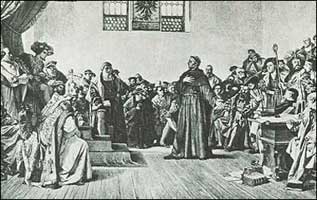
Saint Martin Luther defending his writings before the Emperor Charles V at the Diet of Worms.
In 1521, disguised as a knight, Saint Martin began working on his incomparable translation of the New Testament from Greek into German. The devil was furious and full of hellish rage. This is where the famous incident of throwing ink at the devil took place.
Dreadful noises in his chamber at night would awaken him from sleep. Howling as of a dog could be heard at his door, and on one occasion, as he sat translating the New Testament, an apparition of the Evil One, in the form of a lion, seemed to be walking round and round him, and preparing to spring upon him. Seizing the weapon that came first to his hand, which happened to be his inkstand, Luther hurled it at the devil with such force, that he put the fiend to flight, and broke the plaster on the wall.
Wartburg Castle where Saint Martin worked on his Greek to German translation of the New Testament.
After his excommunication by Pope Leo X and his refusal to recant at the Diet of Worms, Saint Martin was taken to this castle for safety at the request of Frederick the Wise.
This is the room where Saint Martin translated the New Testament into German.
It was during this period that he, under the name of Junker Jörg (the Knight George), translated the New Testament into German.
The German translation had a miraculous effect on the entire nation. Multitudes were seeing for themselves how far the church of Rome had fallen from the original faith of the Apostles.
The Diet of Speyer of 1526So quickly did the Truth spread that in 1526, the Reformed Christians had a meeting with the archduke Ferdinand (brother of Emperor Charles V) to remove the excommunication and ban on Luther and give official recognition to the Reformation.
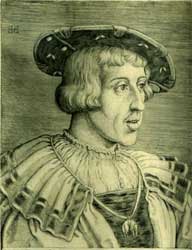
Archduke Ferdinand
(1503–1567).
Emperor Charles V was too preoccupied with keeping England from following the example of Germany and breaking with Rome completely.
He 1526, his brother, Archduke Ferdinand removed the ban of the Empire.
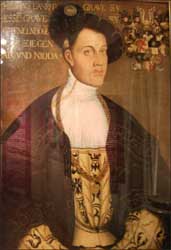
Philip I Langrave of Hesse
(1504-1567).
Philip of Hesse (known as Philip the magnanimous) was the driving force behind the acceptance of the Reformation in Germany.
With the reading of the Bible in the vernacular, the Truth advanced so rapidly that the execution of the Edict of Worms became less and less practicable. This was made manifest at the imperial Diet of Speyer, held in the summer of 1526 under Archduke Ferdinand, in the name of the Emperor.
The Reformed princes dared here for the first time to profess their faith, and were greatly strengthened by the delegates of the imperial cities in which the Reformation had made great progress. The threatening invasion of the Turks, and the quarrel of the Emperor with the Pope over the divorce of Henry VIII, favored the Reformation and inclined the Roman Catholic majority to forbearance.
The origin of the name Protestant at the Diet of Speyer in 1529
Protestantism got its name as followers of Martin Luther protested a ruling by the Diet of Speyer forbidding the teaching of Scripture in Catholic states while letting Roman Catholics teach in Lutheran states.

The 1529 Diet of Speyer.
Saint Martin wrote almost 100 volumes and never once did he refer to himself or his followers by any other name than CHRISTIAN.
He never called his followers Lutherans orProtestants.
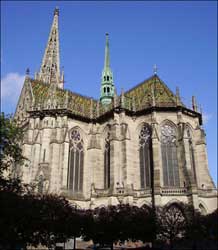
Speyer Memorial church at which the famous protest took place.
Protestantism had its origin in the famous protest against the revoking of the freedoms granted to the Reformed Christians in 1526.
Rome had monopolized the name CHRISTIAN since the time of Emperor Constantine. When the Greeks split from the Romans in 1054, she arrogated the name CATHOLIC or UNIVERSAL even though she was now confined to Western Europe.
Obviously the Papacy was not going to give the followers of Martin Luther their proper designation of Christians or Reformed Christians, so a new term (Protestant) was invented to describe those who adhered to the Bible exclusively as the sole source of faith and doctrine.
Many referred to the rediscovery of the Bible as the new learning or new religion but this was a misnomer as the original teachings of Christianity were based on the Word of God alone.
So mightily did the Word of God prevail in Germany that it was 100 years before the Jesuits launched their initial war of extermination against the Reformed Christians. It was called the 30 Years' War.
The Jesuit instigated 30 Years' War (1618–1648).In 1618, a fearful struggle began among the nations of Europe. Engineered by the Jesuits to destroy the Reformation in Germany, it caused the deaths of countless millions and Germany's population was reduced by over one half.
The Jesuit engineered 30 Years' War was one of the most savage conflicts in the history of the world and no slaughter of such magnitude appeared until WWI.
The U.S. Civil War was a bloody conflict, but that war lasted only 5 years, and the antagonists did take prisoners. Multiply that conflict by SIX and you get some idea of what the war was like.

Jesuit general Mutius Vitelleschi, Black Pope from 1615 to 1645, started the 30 Years' War.
Jesuit general Mutius Vitelleschi started the 30 Years' War with the goal of completely destroying the Reformation in Germany.
His tool was the Emperor Ferdinand II who eliminated his predecessor and became unholy Roman Emperor in 1619.

Emperor Ferdinand II (1578–1637).
Reigned from 1619 to 1637.
The terrible conflict was mostly confined to Germany, but most countries sent mercenaries to fight on either side.
King Gustavus of Sweden saved the Reformation in Germany!!When all hope was gone and the imperialists were preparing to invade Germany and completely destroy the Reformation, God raised up a champion to save the Christians from complete extinction. His name: King Gustavus of Sweden—the Lion of the North.

King Gustavus (1594–1632).
Reigned from 1611 to 1632.
The Lion of the North invaded Germany in July 1630, with a small army of only 4,000 men.
He won battle after battle and soon the timid Germans joined his forces.

Death of King Gustavus at the
Battle of Lutzen in 1632.
Determined to march to Austria and depose Ferdinand II, he was killed at the Battle of Lutzen in 1632.
The Peace of Westphalia in 1648Of course the Jesuit general was delighted with the death of the king of Sweden. His rejoicing was turned into mourning however when the French entered the conflict. The imperialists were deemed invincible but the victories of King Gustavus encouraged the French to help the Swedes.
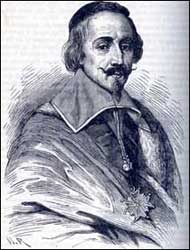
Cardinal Richelieu (1585–1642).
Prime Minister from 1624 to 1642.
The French were greatly encouraged by the many victories of the Swedes over the imperialists.
Cardinal Richelieu concluded an alliance with Sweden to help the Protestant states of Germany.
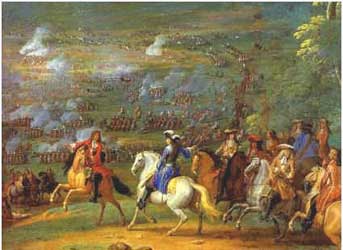
Battle of Rocroi in 1643 in which French
forces soundly defeated the imperialists.
The French won many victories, and finally the war was ended with the Peace of Westphalia in 1648.
When the war ended with the Peace of Westphalia in 1648, there was nothing left to fight over. Europe was ruined....France emerged the clear winner under the leadership of Cardinal Richelieu. The unholy Roman Empire was greatly weakened and Spain was forced to sign a peace treaty with Holland ending the 80 Years' War.
The liberation of Rome in 1870The next great victory for the Reformation was the fall of the Papal States in 1870.
The Franco-Prussian War or Franco-German War, often referred to in France as the 1870 War (July 19, 1870-May 10, 1871), was a conflict between France and Prussia, which was backed by the North German Confederation and the south German states of Baden, Württemberg and Bavaria.

German Emperor William I (1797–1888).
Reigned from 1861 to 1888.
The Franco-Prussian war was a lightning victory of Prussia over Napoleon III.
The soldiers of Emperor Napoleon III were garrisoning Rome and had to be withdrawn following the defeat of France in the war.

Otto von Bismarck (1815–1898).
Chancellor of Germany from 1871 to 1890.
In order to defend Paris, the French soldiers had to be withdrawn from Rome, and the Italian patriots rushed in, and declared the city their capitol after a long wait of over 1500 years.
The medical murder of Kaiser Frederick IIIPrince Frederick William was next in line to the throne after his father, Emperor William I. He was married to Princess Victoria, eldest daughter of Queen Victoria. After his father died, he was Emperor for 99 days only.
His death caused a world war, while the death of his grandfather, Prince Albert, prevented a war between the United States and Great Britain.
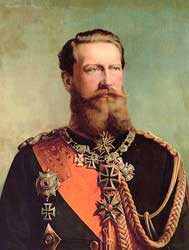
Kaiser Frederick III (1831–1888).
Reigned only 99 days.
Emperor Frederick III was married to the eldest daughter of Queen Victoria, thus cementing an alliance of peace and friendship between Great Britain and the German Empire.
After reigning for only 99 days he died of throat cancer!!

Princess Victoria (1840–1901).
Wife of Emperor Frederick III.
Kaiser Frederick III had nothing in common with "Blood and Iron" Bismarck so he had a timely demise.
His son, William II, succeeded him and he was the notorious Kaiser of World War I. .
The Jesuits were intent on starting another war in Europe in order to recover the lost Papal States.
The last thing in the world they wanted was peace between the British and the German Empires....Peace loving Emperor Frederick III was assassinated to make way for his belligerent son, William II.
The World WAR I KaiserAfter the murder of his father, William II became German Emperor, and began a massive naval buildup in order to surpass the Royal Navy. Of course the excuse to go to war was that Germany was surrounded by Great Britain, France and Russia!!
He dreamed of repeating the lightning Prussian victory of 1870 over France, but this time his hopes were disappointed, because the plans of the Jesuits are always doomed to failure.

Kaiser William II (1859–1941).
Reigned from 1888 to 1918.
The militant Kaiser William II succeeded in the place of his murdered father.
Of course his advisers were Jesuits urging him to go to war to restore the lost states.
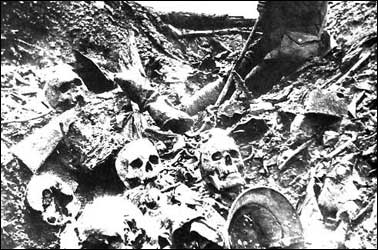
Massive German casualties at the battle of Verdun. Europe had not seen such a bloody conflict since the 30 Years' War.
The war turned out to be a disaster for the Kaiser and he abdicated on November 9, 1918.
Total casualties of World War I amounted to 10 million dead and 20 million wounded worldwide. If we include the Spanish flu, which happened shortly thereafter, the figure is a staggering 30 to 50 million killed!!
Hitler was a British "courier" during World War IEvery war is just a precursor for the next one as the defeated always plan revenge. Hitler arrived in Germany from England in 1913—just in time to be a "courier" during the war.
"Courier" is just an euphemism for spy.
 Hitler can be seen on the left
Hitler can be seen on the left
with his fellow soldiers.
The swastika and skull and bones are all Jesuit symbols.
Hitler was a well-trained Jesuit and spy during the war.

Adolf Hitler (1889–1962).
Fuhrer from 1933 to 1945.
Hitler had a Jesuit in his ancestry because his grandmother, Maria Anna Schicklgruber, was raped while working in the Rothschild castle in Austria.
Hitler signed a concordat with the Vatican in 1933 and would definitely have restored the Papal States if he had won the war.
Total casualties of the Jesuit instigated World War II amounted to about 100 million dead.
See more:
http://www.reformation.org/jesuits-in-germany.html
--------------------
- By Gus Leonisky at 14 Nov 2018 - 7:53am
- Gus Leonisky's blog
- Login or register to post comments
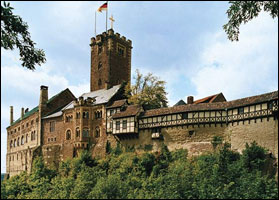

about the author of the pig...
Claudine Fabre-Vassas is an ethnologist.
Having successfully presented her thesis on Ethnology in 1992 at the École des Hautes Etudes en Sciences Sociales (E.H.E.S.S.), she became a fully fledged Doctor.
Director of research at the CNRS, she has been Professor of Ethnology of Europe at the Ecole des Hautes Etudes en Sciences Sociales in Toulouse.
Since 2008, she has been an elected member of the National Committee of CNRS (section 38) and appointed member of the jury of the admission commission within the Laboratory Interdisciplinary, Solidarities, Societies, Territories at the University Toulouse - Jean Jaurès.
Her current research: Christian identity and symbolic food; The "feminine of religion": relationship between the rite, the body and the letter in Judaism; Rites, aesthetic practices, cultural forms.
Member of the editorial board of the magazine "Field", she coordinated several themed issues (Drinking, Death, Dance, Man-Woman).
Translation by Jules Letambour
Read:
https://www.babelio.com/auteur/Claudine-Favre-Vassas/116476
meanwhile, remembering hitler...
The Hitler Diaries (German: Hitler-Tagebücher) were a series of sixty volumes of journals purportedly written by Adolf Hitler, but forged by Konrad Kujau between 1981 and 1983. The diaries were purchased in 1983 for 9.3 million Deutsche Marks(£2.33 million or $3.7 million) by the West German news magazine Stern, which sold serialisation rights to several news organisations. One of the publications involved was The Sunday Times, who asked their independent director, the historian Hugh Trevor-Roper, to authenticate the diaries; he did so, pronouncing them genuine. At the press conference to announce the forthcoming publication, Trevor-Roper announced that on reflection he had changed his mind, and other historians also raised questions concerning their validity. Rigorous forensic analysis, which had not been performed previously, quickly confirmed that the diaries were fakes.
Kujau, born and raised in East Germany, had a history of petty crime and deception. In the mid-1970s he began selling Nazi memorabilia which he was smuggling from the East, but soon found he could raise the prices by forging additional authentication details which linked ordinary souvenirs to the Nazi leaders. He began forging paintings by Hitler and an increasing number of notes, poems and letters, until he produced his first diary in the mid- to late 1970s. The West German journalist with Stern who "discovered" the diaries and was involved in their purchase was Gerd Heidemann, who had an obsession with the Nazis. When Sternstarted buying the diaries, Heidemann stole a significant proportion of the money provided.
Kujau and Heidemann both spent time in prison for their parts in the fraud, and several newspaper editors lost their jobs. The story of the scandal has been the basis of various films: Selling Hitler (1991) for the British channel ITV and the German cinema release Schtonk! (1992).
Read more:
https://en.wikipedia.org/wiki/Hitler_Diaries
------------------------------
Did Adolf Hitler ever visit Liverpool, and if so, why?
P. M. Ray, Harrogate, N Yorks.
Alan Love, Pidley, Cambs.
(Miss) M. Summers, Liverpool 4.
B. G. Hughes, Liverpool 23.
Jane Speare, Alton, Hants.
(Dr) Moss Madden, Liverpool.Before 1992 there were many unrelated events that could jog the imagination and set off the idea of a hoax. Apart from the Hitler and Mussolini fake diaries, we had a specifically Liverpudlian scam in the form of "THE MEMOIRS OF BRIDGET HITLER". These claimed that Adolf Hitler had actually lived in Liverpool for some months in 1912-13. They were first dealt with in 1973 in a series of lengthy articles in the 'Liverpool Daily Post'. Book publication followed in 1979.
These memoirs then inspired the novel "YOUNG ADOLF" by Beryl Bainbridge. More than one wily Liverpudlian noted that there was fun and cash to be gained from a gullible reading public.
(From http://www.casebook.org/dissertations/maybrick_diary/mhguide.html )
Christopher T. George, Baltimore, USA
Christopher T. George, Baltimore, USA
John David Hume, Liverpool England
C Holmes, London U.KRead more:https://www.theguardian.com/notesandqueries/query/0,5753,-1915,00.html
luther and the pope...
An embittered Vatican insider (many of them saw this day coming) has leaked the document that Pope Francis has been working on together with Lutheran leaders: Stultus Aprilis.
Pope Francis, always surprising people during the four years so far of his pontificate, is preparing to announce that Martin Luther is certainly in heaven. This is called equipollent canonization – where, by virtue of his position as the Vicar of Christ, Pope Francis can bypass the ordinary judicial process of canonization.
Reformation experts think that the most likely date of the proclamation of Stultus Aprilis is on October 31. This year, that date marks exactly 500 years since Martin Luther nailed his 95 theses on the church door of Wittenberg.
It is clear that, at least for Roman Catholics, Martin Luther will be able to be referred to as “Saint Martin Luther”. This builds on the work of Pope Saint John Paul II who, in the year celebrating 500 years since Martin Luther’s birth, titled Martin Luther “Doctor”. Plans are also underway to commemorate Martin Luther on a Vatican stamp. “Usually if individuals are commemorated on stamps they are saints.”
Read more:
http://liturgy.co.nz/pope-francis-to-make-martin-luther-a-saint-on-octob...
This could be another hoax.... We're swimming in it...
the more dumplings you eat, the more money you'll have...
February 5 marks the first official day of the Chinese New Year, which celebrates the Year of the Pig.
But it's not hard to guess, with the city showcasing every pig decoration you can think of — even piglets have made appearances at some celebrations.
For those born in the Year of the Pig, 2019 is predicted to be a year of emotional ups and downs with mostly poor luck in health, love, career and finance.
But, those poor outlooks weren't the focus of the event, with revellers wishing one another good fortune and prosperity.
Of course at the heart of Chinese New Year is delicious food and on Tuesday Sydney broke the world record for the number of people eating dumplings at once.
Chinese tradition dictates that the more dumplings you eat, the more money you will have.
Read more:
https://www.abc.net.au/news/2019-02-05/chinese-new-year-kicks-off-in-syd...
See also why we illustrate bankers as pigs:
are bankers humans?Read from top...